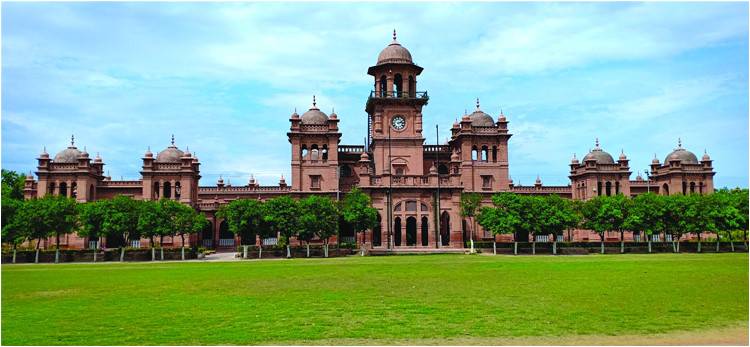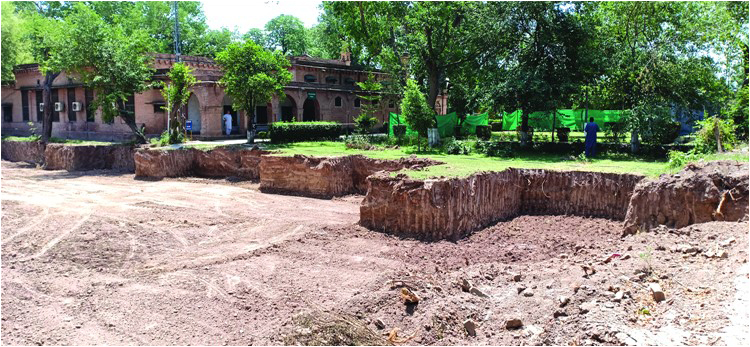
If you still haven’t seen the iconic and historic Islamia College University of Peshawar, you can still have some idea of its beauty from the picture that adorns the 1000-rupee note in Pakistan.
Perhaps there would be hardly anyone amongst the alumni of the college – the history of which spans more than 100 years – and in nearby campuses of the University of Peshawar, University of Engineering and Technology, Khyber Medical College and Agriculture University who has not posed for photographs with the arched college building and orange trees in the background.
The incumbent administration of the institute has started construction of new buildings for its Administration Block, IT Block, Social Sciences Block, Centre for Omic Sciences, Library, Gymnasium, Vice Chancellor House, visiting faculty lodges and reconstruction of the main gate – all of which is to come at a cost of Rs 1.38 billion.
The Vice Chancellor of the University, Dr. Habib Ahmad notes that the project has been started to meet the demands of the growing number of students.

But the project has triggered a debate on social media, especially amongst alumni of the college, who have voiced their concerns over jeopardizing the aesthetics, serenity and ambience of the majestic structure built in 1913.
The contractor has already dug out the lawns opposite to the historical Oriental Hostel and Khushal Hostel of the college for the construction of the IT block and Centre for Omic Sciences.
Similarly, the lawn behind the central library has been dug out for the construction of the new Mohammad Ali Jinnah Library.
The college administration says that the project is being constructed far away from the main building of the college—the one on the currency note—but the above-mentioned hostels are also being constructed over areas that are part of the 100-year history of the institution.
Experts say that any construction near the historic building would not only affect the ambience and serenity of the two hostels by occupying the breathing spaces left for the students in the original master plan of the college, but will also damage the old buildings.
The Institute of Architects of Pakistan (IAP), Pakistan Council of Architects &Town Planning (PKATP), KARWAN, National Heritage Council, International Council Of Monuments and Sites (ICOMOS) and the Sarhad Conservation Network (SCN) have issued a joint statement urging the government to stop the project to save the priceless building structures of the institution.
Adil Zareef of Sarhad Conservation Network tells The Friday Times:
“Islamia College is not an ordinary government institution. It is a unique heritage which has a vision behind it. Its sanctity, landscape and originality should be kept intact. You can’t teach students by closing them in cages like so many chickens. Students need consideration for their mental and physical health.”

He adds that the KP government passed the KP Antiquities Act 2016 but the Archaeology Department did not notify the college and other historical buildings so as to extend heritage protection to them.
“The college has vast land in Swabi and Charsadda. Why don’t they build the expansion over there? Why are they forcing students to come to the already congested Peshawar city? Why don’t they build other campuses of the college in other cities to reduce burden on Peshawar?” he asks.
Architect Tahir Khattak says:
“Right now, the college is only a heritage site of Pakistan but if you apply to UNESCO for declaring it a world heritage site, its importance would be increased beyond imagination. But if you make changes in the original master plan you won’t meet the criteria from UNSESCO needed for declaration of a site as one of World Heritage.”
Moreover, he points out, the project would ruin the landscaping of the college as its roads would then need to be widened after the increase in traffic.
He emphasizes that the college administration has alternatives to address the needs of the students but they are not paying attention to heritage considerations.
“The interventions in the past in the original master plan are also violations but probably at that time no one raised objections. Right now, we have raised our voice against the destruction.”
The administration, however, says that the buildings are constructed away from the main building and are not even visible from the main building built in 1913.
Tahir Khattak responds that the main building and hostels are both one hundred years old. And thus both have a similar importance.
But Mohammad Zaman Khan, President of the Senior Alumni Association, is not worried. He comes out in support of the administration’s stance. He says that the buildings are being constructed in a way that they do not impact the aesthetics of the historical building. “We won’t let anyone change even a single brick in the main building. We have a very strong association, with thousands of members, which is the custodian of the college,” he notes confidently.
The college/university administration say that they have completed all the formalities. The director KP Directorate of Archaeology and Museums was present in the master planning of the project and Pakistan’s reputed firms have designed it. We are told that consultants did the necessary environmental and social assessment. In fact, we are told that the administration even involved in this process a person who did his PhD work on Bhai Ram Singh, the architect of the main building – all so that the new building could blend with the old one.
“We are not executing the project with closed eyes,” assures Dr. Habib Ahmad, the Vice Chancellor. He says further that the Planning Commission Islamabad and Higher Education Commission have approved it. “We desperately needed the project as the college was built for the needs of students 100 years back and since then no had bothered to ensure expansion to meet the needs of the modern age.”
Dr. Habib Ahmad adds that in 2008, the college was given university status and classes were started in the existing infrastructure – which was already insufficient for the college students. “We are running the university in very congested situation. The project would cater to the needs of the coming 50 years of the university,” he believes.
As far as he is concerned, people are against the project for their “vested interest” and that the alumni association are sufficient to block any step that affects the heritage value of the college.
Perhaps there would be hardly anyone amongst the alumni of the college – the history of which spans more than 100 years – and in nearby campuses of the University of Peshawar, University of Engineering and Technology, Khyber Medical College and Agriculture University who has not posed for photographs with the arched college building and orange trees in the background.
The incumbent administration of the institute has started construction of new buildings for its Administration Block, IT Block, Social Sciences Block, Centre for Omic Sciences, Library, Gymnasium, Vice Chancellor House, visiting faculty lodges and reconstruction of the main gate – all of which is to come at a cost of Rs 1.38 billion.
The Vice Chancellor of the University, Dr. Habib Ahmad notes that the project has been started to meet the demands of the growing number of students.

But the project has triggered a debate on social media, especially amongst alumni of the college, who have voiced their concerns over jeopardizing the aesthetics, serenity and ambience of the majestic structure built in 1913.
The contractor has already dug out the lawns opposite to the historical Oriental Hostel and Khushal Hostel of the college for the construction of the IT block and Centre for Omic Sciences.
Similarly, the lawn behind the central library has been dug out for the construction of the new Mohammad Ali Jinnah Library.
The college administration says that the project is being constructed far away from the main building of the college—the one on the currency note—but the above-mentioned hostels are also being constructed over areas that are part of the 100-year history of the institution.
The Institute of Architects of Pakistan (IAP), Pakistan Council of Architects &Town Planning (PKATP), KARWAN, National Heritage Council, International Council Of Monuments and Sites (ICOMOS) and the Sarhad Conservation Network (SCN) have issued a joint statement urging the government to stop the project to save the priceless building structures of the institution
Experts say that any construction near the historic building would not only affect the ambience and serenity of the two hostels by occupying the breathing spaces left for the students in the original master plan of the college, but will also damage the old buildings.
The Institute of Architects of Pakistan (IAP), Pakistan Council of Architects &Town Planning (PKATP), KARWAN, National Heritage Council, International Council Of Monuments and Sites (ICOMOS) and the Sarhad Conservation Network (SCN) have issued a joint statement urging the government to stop the project to save the priceless building structures of the institution.
Adil Zareef of Sarhad Conservation Network tells The Friday Times:
“Islamia College is not an ordinary government institution. It is a unique heritage which has a vision behind it. Its sanctity, landscape and originality should be kept intact. You can’t teach students by closing them in cages like so many chickens. Students need consideration for their mental and physical health.”

He adds that the KP government passed the KP Antiquities Act 2016 but the Archaeology Department did not notify the college and other historical buildings so as to extend heritage protection to them.
“The college has vast land in Swabi and Charsadda. Why don’t they build the expansion over there? Why are they forcing students to come to the already congested Peshawar city? Why don’t they build other campuses of the college in other cities to reduce burden on Peshawar?” he asks.
Architect Tahir Khattak says:
“Right now, the college is only a heritage site of Pakistan but if you apply to UNESCO for declaring it a world heritage site, its importance would be increased beyond imagination. But if you make changes in the original master plan you won’t meet the criteria from UNSESCO needed for declaration of a site as one of World Heritage.”
Moreover, he points out, the project would ruin the landscaping of the college as its roads would then need to be widened after the increase in traffic.
He emphasizes that the college administration has alternatives to address the needs of the students but they are not paying attention to heritage considerations.
“The interventions in the past in the original master plan are also violations but probably at that time no one raised objections. Right now, we have raised our voice against the destruction.”
The administration, however, says that the buildings are constructed away from the main building and are not even visible from the main building built in 1913.
Tahir Khattak responds that the main building and hostels are both one hundred years old. And thus both have a similar importance.
But Mohammad Zaman Khan, President of the Senior Alumni Association, is not worried. He comes out in support of the administration’s stance. He says that the buildings are being constructed in a way that they do not impact the aesthetics of the historical building. “We won’t let anyone change even a single brick in the main building. We have a very strong association, with thousands of members, which is the custodian of the college,” he notes confidently.
The college/university administration say that they have completed all the formalities. The director KP Directorate of Archaeology and Museums was present in the master planning of the project and Pakistan’s reputed firms have designed it. We are told that consultants did the necessary environmental and social assessment. In fact, we are told that the administration even involved in this process a person who did his PhD work on Bhai Ram Singh, the architect of the main building – all so that the new building could blend with the old one.
“We are not executing the project with closed eyes,” assures Dr. Habib Ahmad, the Vice Chancellor. He says further that the Planning Commission Islamabad and Higher Education Commission have approved it. “We desperately needed the project as the college was built for the needs of students 100 years back and since then no had bothered to ensure expansion to meet the needs of the modern age.”
Dr. Habib Ahmad adds that in 2008, the college was given university status and classes were started in the existing infrastructure – which was already insufficient for the college students. “We are running the university in very congested situation. The project would cater to the needs of the coming 50 years of the university,” he believes.
As far as he is concerned, people are against the project for their “vested interest” and that the alumni association are sufficient to block any step that affects the heritage value of the college.

